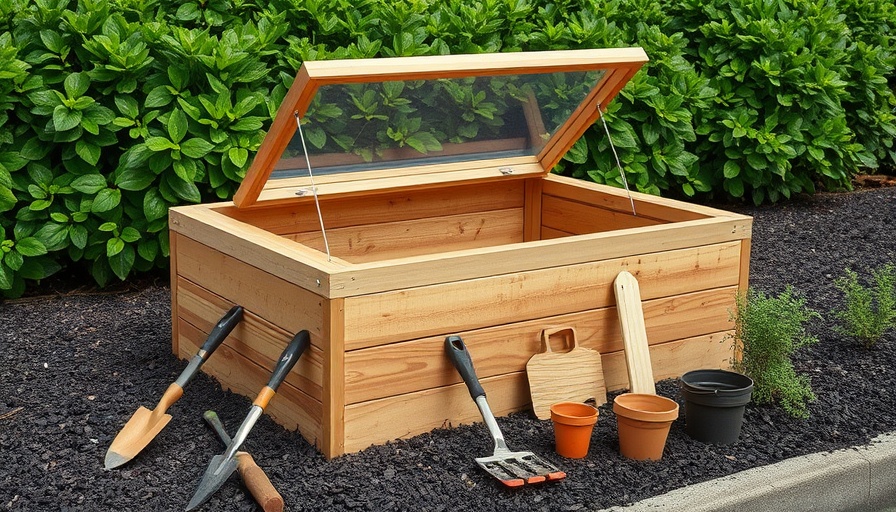
Why a Cold Frame is Essential for Your Eco-Conscious Garden
As autumn settles in, the urge to retire from gardening may seem alluring. However, if you’re a boutique hospitality professional looking to provide guests with a taste of fresher fare, a cold frame can be your secret weapon for year-round gardening. Picture a lovely garden where winter doesn’t call for a complete cessation in growth. With the proper setup, you can not only prolong your growing season but cultivate a vibrant microclimate capable of nurturing vegetables even beneath blankets of snow.
Understanding the Basics: What is a Cold Frame?
A cold frame is quite simple in design: a bottomless box that allows sunlight to bathe its contents while protecting plants from bitter cold. According to sustainable gardening principles, building a cold frame isn’t just about cost-effectiveness — it’s also about embracing eco-friendly practices like repurposing materials. Utilizing an old window for the top and untreated lumber for the sides honors the zero-waste philosophy many modern entrepreneurs uphold.
Imagine guests arriving at your eco-lodge and finding fresh kale or herbs right outside, even in the chill of winter. A cold frame can elevate your hospitality game by connecting visitors to the soil, freshness, and the behind-the-scenes workings of sustainable home design.
Harvesting Through the Seasons: The Year-Round Advantage
Cold frames tend to be underestimated as mere season extenders. However, they can truly offer a steady production of fresh produce throughout the year if managed right. These structures act as passive solar collectors that filter heat during sunny spells while acting as a shield against the elements. This balance is indispensable for maintaining a steady environment that allows cold-hardy crops to thrive.
Crucially, growing in a cold frame opens up a world of possibilities, allowing cooler-weather crops such as spinach, kale, and various lettuce types to continue their journey of growth. With proper crop rotation and succession planting, you can enjoy a continuous harvest of delectable greens, even including flavorful herbs like thyme or oregano that can survive through winter.
Materials for Your Cold Frame: Making It Cost-Effective & Sustainable
Constructing your garden's cold frame can be a straightforward process, and more importantly, it can align with your sustainability goals:
**1 2×8 board, 3 feet long**: This will serve as the front wall.
**1 2×12 board, 12 feet long**: After cutting into segments (3-foot, 4-foot pieces), this will form the back and sides.
**Old windows or clear plastic**: Perfect for the top, allowing sunlight in while keeping cold air out.
**Hinges**: To create a door for easy access.
**Basic tools**: Saw, drill, screws, tape measure, and pen.
By reusing materials you might otherwise discard, you're embracing both cost-effectiveness and eco-friendly gardening.
Keeping the Balance: Airflow and Temperature Regulation
The beauty of a cold frame is in its adaptability. It's crucial to manage airflow on milder winter days to prevent overheating. Skilled gardeners share anecdotes of dining on fresh salads while the world outside is icy. These accounts highlight how an effectively managed cold frame can support delicate growth during the harshest of climates.
Empowering Guest Experiences Through Garden-Fresh Produce
For boutique hospitality professionals eager to enhance guest experiences, cultivating a garden through time and season translates into diverse culinary options. Guests in eco-conscious lodgings can enjoy meals prepared with ingredients harvested just outside their door. Think herb-infused oils or salads that offer a taste of the sweetest moments in nature. Engaging guests with the process of gardening—like including them in the harvesting—creates memorable experiences that reflect sustainability and connection to nature.
Conclusion: Grow and Share Your Garden's Bounty
As the cold winds approach, don't retreat into a winter hibernation with your gardening plans. By creating a cold frame, you embrace the ideals of energy efficiency, water conservation, and toxin-free gardening practices that align beautifully with an eco-friendly lifestyle. Not only does it enhance the sustainability aspect of your hospitality, but it also enriches the experiences you provide. Take the leap this season—consider building your cold frame and witness the joys of year-round gardening.
 Add Row
Add Row  Add
Add 




Write A Comment